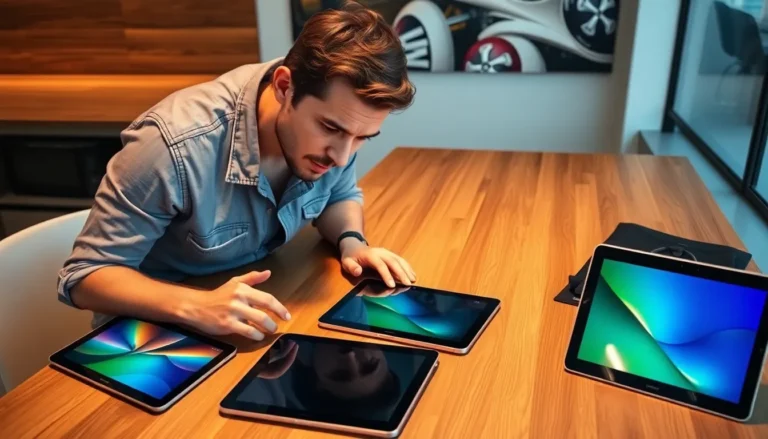Are you ready to launch into the cosmic age? New space technology is taking us beyond the gravitational tug of Earth, transforming our view of the universe as we know it. Imagine satellites that can dodge asteroids or rockets that can take off anywhere and land anywhere. The future is not just bright: it’s interstellar. In this blog, we’ll investigate into recent advancements, the dynamic interplay between public and private sectors, and the innovative technologies reshaping space exploration. Buckle up, because the countdown to the exciting future of space technology begins now.
Table of Contents
ToggleOverview of Space Technology Advancements

Space technology has leaped forward in recent years, with innovations that seem straight out of science fiction. From reusable rockets to satellite constellations providing global internet coverage, the advancements are monumental. One standout development is the growing use of artificial intelligence (AI) to enhance spacecraft autonomy. This means spacecraft can make real-time decisions, which is invaluable during critical mission phases.
Also, the miniaturization of technology allows for smaller satellites to carry out complex tasks. The improved efficiency not only cuts costs but also boosts the volume of data collected from space missions. As a result, researchers can analyze vast quantities of information which leads to more successful missions and novel discoveries.
This dynamic landscape of technology not only expands our scientific knowledge but also democratizes access to space, paving the way for a wide range of applications from Earth monitoring to emergency communication.
The Role of Public and Private Sectors
The collaboration between public and private sectors has been pivotal in the growth of new space technology. Government agencies like NASA have partnered with private companies such as SpaceX and Blue Origin. These partnerships enable the pooling of resources and expertise, which accelerates innovation. For instance, SpaceX’s Crew Dragon spacecraft marked the return of human spaceflight capabilities to US soil, a historic achievement made possible through public-private collaboration.
On the flip side, private companies are pushing the boundaries of what was once solely the realm of governments. They are developing technologies that make launches cheaper and more frequent. The competition between these entities stokes innovation, resulting in faster development cycles. It’s an electrifying time where visionary entrepreneurs are breaking barriers that once seemed insurmountable.
Innovative Technologies Transforming Space Exploration
Several cutting-edge technologies are currently revolutionizing space exploration. One critical innovation is the integration of propulsion systems that use greener, more efficient fuels. Ion thrusters, which are powered by electricity, offer drastic improvements in fuel efficiency. This means spacecraft can venture deeper into the solar system without carrying vast amounts of fuel.
Additive manufacturing is another groundbreaking tool at our disposal. 3D printing allows engineers to build parts on-site in space, reducing the need to launch everything from Earth. This not only saves money but also minimizes the weight burden on spacecraft.
Also, advancements in robotics are placing various tools and instruments at our fingertips. Rovers and drones equipped with AI observe and collect data in environments that are otherwise hostile to human explorers. Mars rovers like Perseverance are prime examples, autonomously navigating the rugged Martian landscape while conducting essential research.
Challenges and Risks in Developing New Space Technologies
While the future of space technology gleams with potential, it also comes with challenges and risks. The development costs are astronomical (pun intended), and financial backing can be shaky. Also, launching new technologies often involves trial and error. Test failures can set projects back and drain budgets.
Regulatory hurdles also pose significant obstacles. Nations strive to establish clear frameworks for space activities, from determining ownership of resources to ensuring the safety of large satellite constellations. The risk of space debris is a growing concern: collisions could render areas of space unusable. This adds urgency to creating technologies that manage or mitigate debris.
These challenges must be addressed with pragmatic solutions to ensure the safety and sustainability of current and future endeavors in space.
The Future of Space Technology and Its Implications
Looking ahead, the landscape of space technology holds immense promise. With the drive for lunar bases and potential missions to Mars, the expansion will become exponentially ambitious. Technologies like space tourism are no longer a pipe dream. Companies are developing frameworks for civilian travel beyond Earth’s atmosphere, offering an entirely new frontier for exploration.
Also, as technology progresses, we can expect a more significant emphasis on collaborations that include not just nations or corporations but also educational institutions. Imagine universities collaborating with space agencies to develop new technologies for exploration.
The implications of advanced space technologies extend all the way down to Earth. From climate monitoring to disaster response, the benefits ripple across various sectors. Innovations developed for space missions may find their place in everyday life, proving that space exploration is indeed a shared try.







